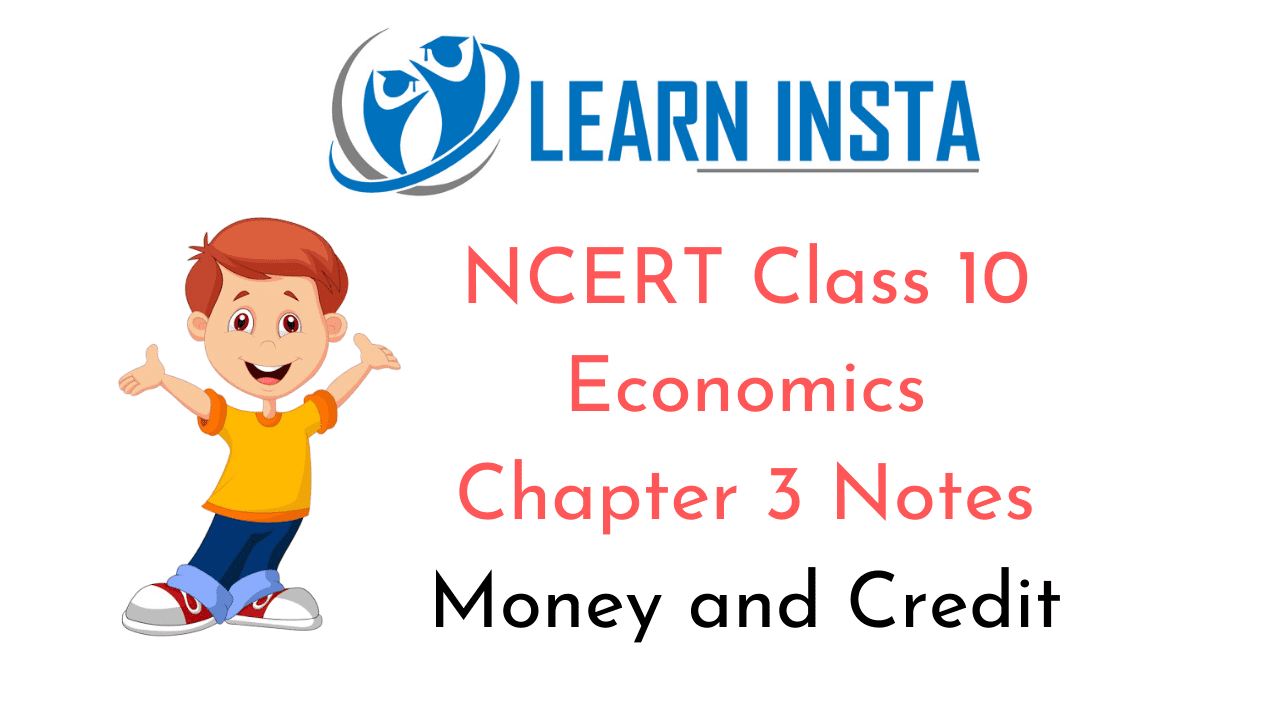 On this page, you will find NCERT Class 10 Economics Chapter 3 Notes Pdf free download. CBSE Class 10 Social Science Notes Economics Chapter 3 SST Money and Credit will seemingly, help them to revise the important concepts in less time.
On this page, you will find NCERT Class 10 Economics Chapter 3 Notes Pdf free download. CBSE Class 10 Social Science Notes Economics Chapter 3 SST Money and Credit will seemingly, help them to revise the important concepts in less time.
Money and Credit Class 10 Notes Social Science Economics Chapter 3
CBSE Class 10 Economics Chapter 3 Notes Understanding the Lesson
1. Money is used as a medium of exchange in transactions. A person holding money can easily exchange it for any commodity or service that he or she might want.
2. Everyone prefers to receive payments in money and then exchange the money for things that they want.
3. In a barter system where goods are directly exchanged without the use of money, double coincidence of wants is an essential feature.
4. In an economy where money is in use, money by providing the crucial intermediate step eliminates the need for double coincidence of wants.
5. Before the introduction of coins, a variety of objects such as grains and cattle were used as money, Thereafter came the use of metallic coins such as gold, silver, copper coins, etc.
6. Modern forms of money include currency of paper notes and coins. Although modern currency is without any use of its own, it is accepted as a medium of exchange because the currency is authorized by the government of the country.
7. In India, the Reserve Bank of India issues currency notes on behalf of the central government. Here the rupee is widely accepted as a medium of exchange.
8. Modern forms of money are linked with the banking system. On one side, there are the depositors who keep their money in the banks while on the other side, there are the borrowers who take loans j from these banks.
9. Banks charge a higher interest rate on loans than what they offer on deposits. The difference between what is charged from borrowers and what is paid to depositors is their main source of income.
10. A large number of transactions in our day-to-day activities involve credit in some form or the other. Credit has a positive impact but in certain circumstances, it makes the borrower worse off.
11. Credit is available from a variety of sources. These can be either formal or informal sources. Terms of credit vary substantially between formal and informal lenders.
12. Among the formal sector, people can obtain loans from banks and cooperatives. The informal lenders include moneylenders, traders, employers, relatives and friends, etc.
13. The Reserve Bank of India supervises the functioning of formal sources of loans. But there is no organization which supervises the credit activities of lenders in the informal sector. They can lend at whatever interest rate they choose.
14. Compared to the formal lenders, most of the informal lenders charge a much higher interest on loans. Thus, the cost of the borrower of informal loans is much higher.
15. At present, it is the richer households who receive credit from formal sources whereas the poor have to depend on the informal sources.
16. It is necessary that banks and cooperatives increase their lending particularly in the rural areas, so that the dependence on informal sources of credit reduces.
17. The poor should get a much greater share of formal loans from banks, cooperative societies, etc. Both these steps are important for development.
18. The reason for dependence of poor households on informal sources of credit is that banks are not present everywhere in rural India. Even when they are present, getting a loan from a bank is much more difficult than taking a loan from informal sources.
19. Absence of collateral is one of the main reasons which prevents the poor from getting bank loans. Informal lenders know the borrowers personally and therefore, they have no problem in giving a loan without collateral.
20. The Self Help Groups or SHGs help borrowers overcome the problem of lack of collateral. They can get timely loans for a variety of purposes and at a reasonable interest rate. The SHGs are also building blocks of organisation of the rural pour.
Money and Credit Class 10 CBSE Notes Important Terms
Transaction: An instance of buying or selling something.
Currency: The system or type of money that a particular country uses.
Cheque: A paper instructing the bank to pay a specific amount from the person’s account to the person in whose name the cheque has been issued.
Credit: An agreement in which the lender supplies the borrower with money, goods or services in return for the promise of future payment.
Collateral: An asset that the borrower owns such as land, building, vehicle, livestock, deposits with banks and uses this as a guarantee to a lender until the loan is repaid.
Money: The means of paying for something or buying something.